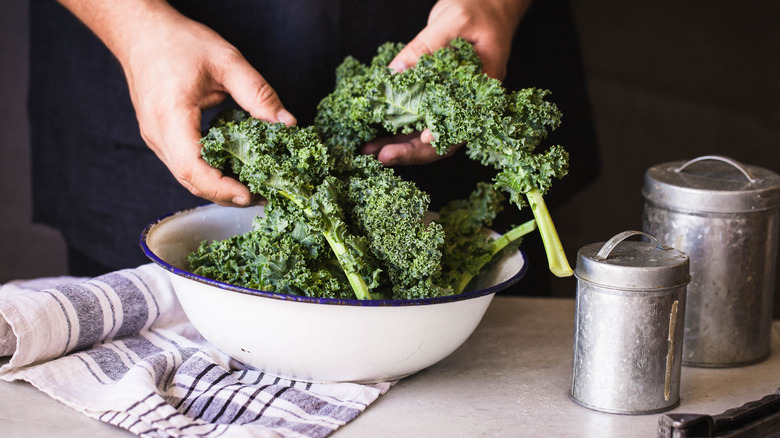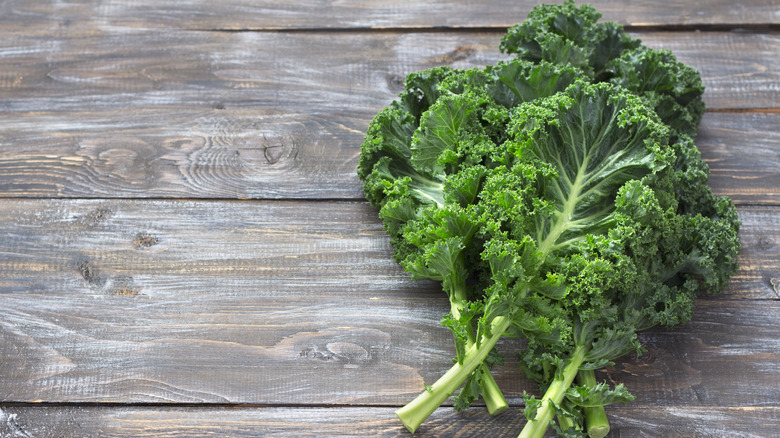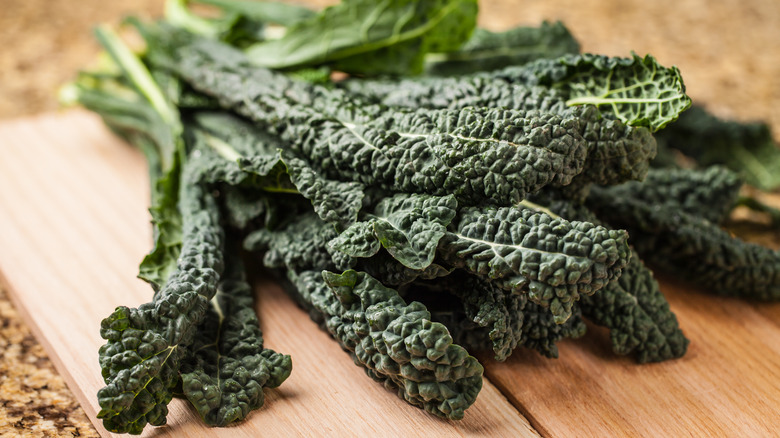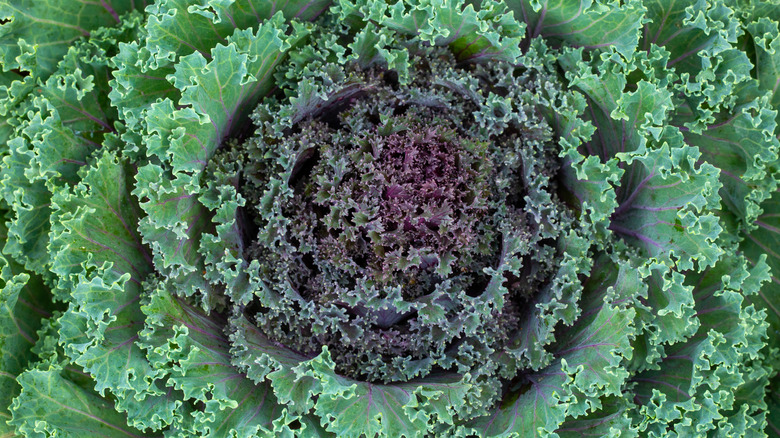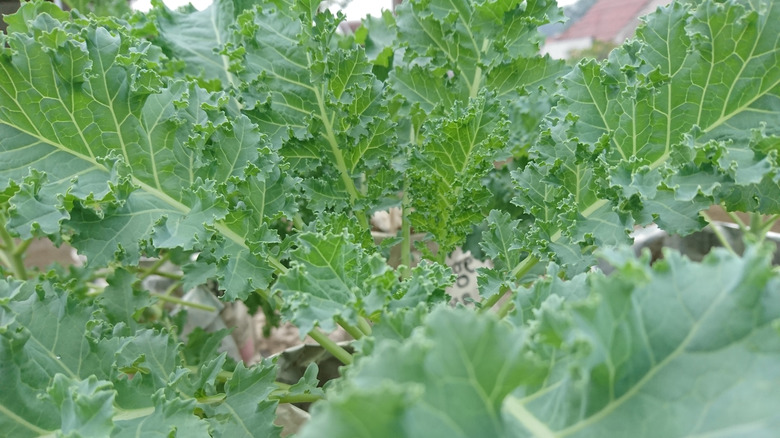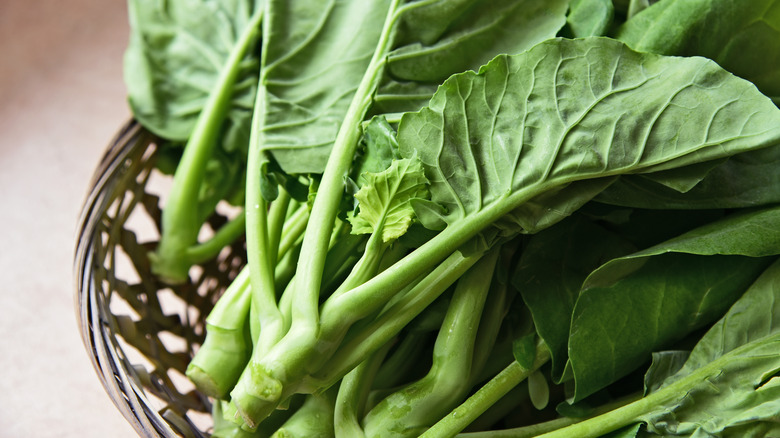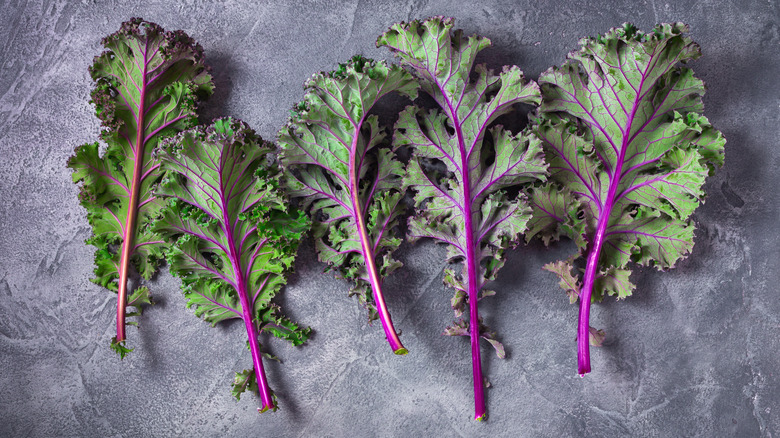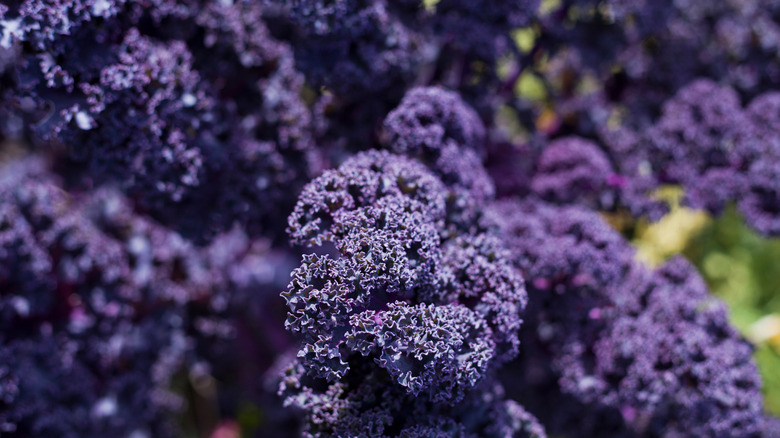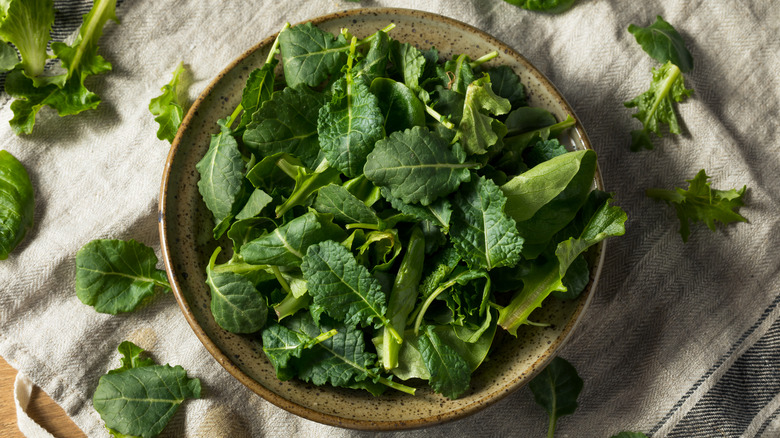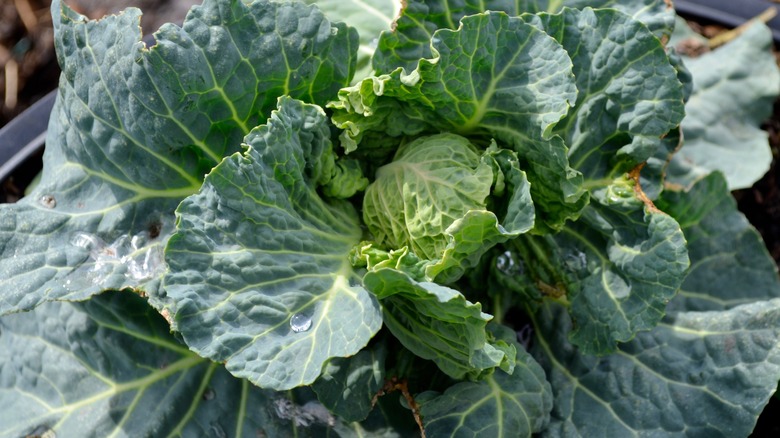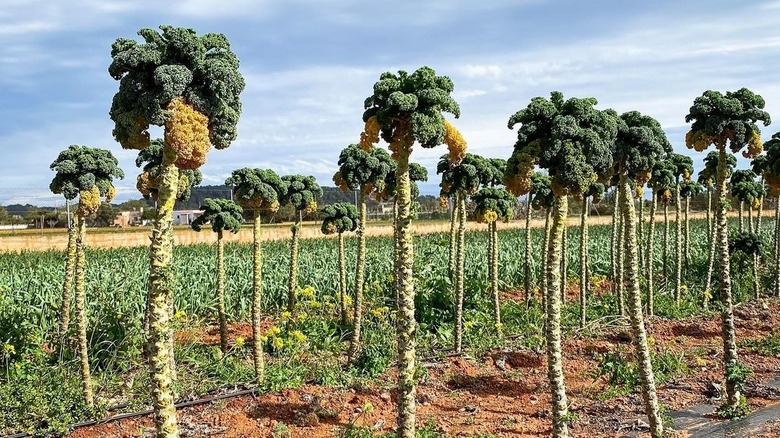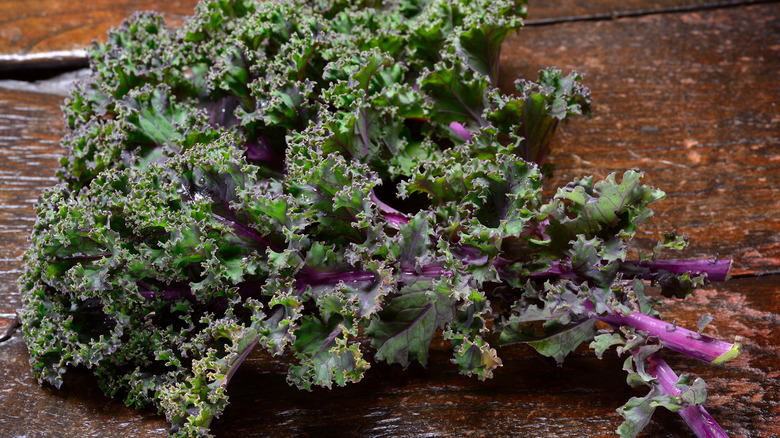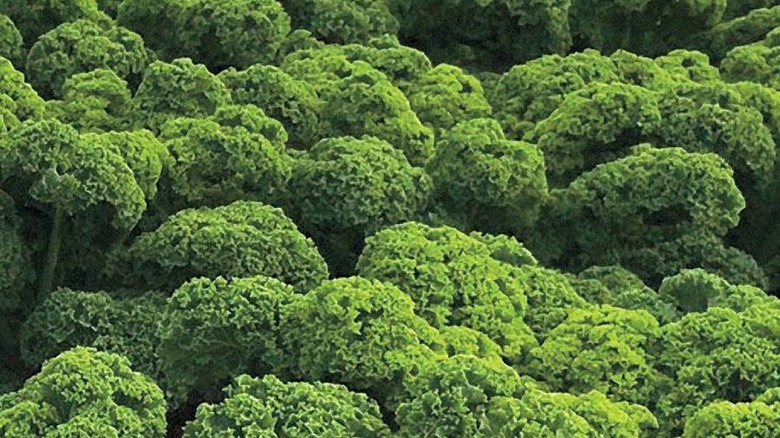13 Different Types Of Kale Explained
Kale tends to attract extreme reactions from people. Either you're firmly on the end of the spectrum that disdains all foods overly green-tasting, or you espouse the delightful crunch of kale chips and grow it in your garden. Sure the occasional person might be indifferent, but there are so many varieties of kale that you're bound to find one of them delicious. If you're wondering why it matters whether the whole world loves kale or not, it's because the shamelessly healthy appearance — which the Cleveland Clinic says is a big draw for health buffs — is the real deal.
As Britannica has it, the cruciferous leafy green is incredibly nutritionally dense, packed with vitamins, minerals, and antioxidants, which assist in keeping your body in tip-top function. Per BBC Good Food, we're talking about immune-boosting properties, protection against cancer and heart disease, and improved bone and eye health. That's a lot of goodness from a plant that gets so many haters! We get it — a sad and bitter kale salad may not motivate anyone to get on board, but our selection of kale varieties might change your mind.
From subtle and sweet to sharp and bitter, different types of kale mean different flavors, colors, and textures. This guide will help you to figure out which types you should track down and, perhaps, plant for yourself.
1. Curly
Even if you've never tasted kale, you're probably familiar with the unabashedly curly variety. Per its name, each bright green leaf (skip those that have started to yellow) has tightly curled edges that create a frilled border. Aside from being aesthetically pleasing, curly kale is the most common variety to find in supermarkets (via MasterClass). According to Heal With Food, the flavor tends towards peppery and bitter, though it depends on how you prepare it in the kitchen. Meanwhile, it is usually slightly sweeter if your curly kale is harvested in the winter season (via New Entry).
Thanks to its hearty leaves, MasterClass writes that eaters can consume curly kale sauteed, boiled, steamed, or roasted. The site also mentions that curly kale is good to eat raw. If you plan to immediately serve the greens in a salad, Bon Appétit recommends properly massaging the leaves with oil until they start to wilt. This process tenderizes the kale, making it more pleasant and palatable. Regardless of your cooking method, New Entry reports that you'll want to begin by adequately rinsing the leaves since the tight curls are the perfect hiding spot for dirt and bugs. Typically, our sources agree that removing the thick stems is also ideal.
2. Lacinato
This member of the kale family goes by many names: lacinato, Tuscan, dino, cavolo nero, Italian kale, and black kale (via The Spruce Eats). There's sense to the various names since the leaves are typically much darker than other types of kale often bordering on shades of blue and black. Savvy Gardening notes that it is native to Italy, further explaining the more Mediterranean names. Heal With Food points out that lacinato is traditionally used in Tuscan cuisine. Although we haven't ever seen a living dinosaur, the textured leaves are evocative of some sort of reptilian skin.
Apart from the color, lacinato leaves tend to be flat, narrow, and elongated with softer, thinner stems that can be eaten, according to The Spruce Eats. Compared with other varieties of kale, the source also notes that lacinato is a bit sweeter and milder, yet it still packs a loamy, nutty flavor into whatever dish you add it to. Since the leaves are thinner, eating it raw means you can skip the massage and go right ahead to dressing your salad. We recommend simmering it in a broth or sauce to soften the texture and add nutrients to your soup or stew. Eataly shares a quintessentially Tuscan recipe — ribollita — as a nourishing soup loaded with vegetables, beans, stale bread, and of course, Tuscan kale.
3. Ornamental
As it sounds, Wisconsin Horticulture writes that ornamental kale is predominantly bred for its beautiful appearance. Typically, frilly leaves frame the center much like flower petals, and the colors can include shades of green, white, pink, red, and purple, according to Gardener's Path. So if you want to add a vibrant splash to your garden, ornamental kale works like a charm. Similarly, if you enjoy creating edible works of art, a couple of leaves as garnish will spruce up any dish.
On the flip side, it's probably not going to be the tastiest variety at the dinner table. Gardener's Path notes that as far as different types of kale go, the flavor isn't as complex and bitterness seems to prevail. Dave's Garden reports that the texture is not especially desirable due to its fibrous and chewy consistency. To remedy this, stick with eating young plants, or as Gardener's Path reports, boil the leaves to reduce the pungent taste. There are plenty of types of ornamental kale (often labeled as cabbage), so Wisconsin Horticulture says to look out for names like Pigeon, Tokyo, Nagoya, and Osaka.
4. Siberian
Siberian kale comes from a different family than most varieties of kale — as Properly Rooted remarks, it's more closely related to rutabaga or canola plants. Seed Ambassadors suggests Siberian kale is a hybrid of two species that came to be in the Middle Ages. Seed Ambassadors write that this variety is a good choice if you're looking to plant disease-resistant kale that will endure cold winters or sweltering summers.
Although it's not closely related to the typical types of kale you can find in the supermarket, it's still a leafy green, albeit slightly softer and milder in flavor than other varieties, per Missouri Botanical Garden. Consequently, we can recommend Siberian kale as an excellent raw salad ingredient. If you want a green smoothie that doesn't taste too green, you'll get all the nutrients and a far subtler taste if you blend in some Siberian kale. Seed Ambassadors equally advises steaming, boiling, or sauteeing this variety, making it a truly versatile leafy green.
5. Chinese
You might know Chinese kale best as Chinese broccoli or gai lan, but this leafy green is actually a member of the kale family, Diversivore reports. The flavor is reminiscent of broccoli which explains the alternate moniker; however, you'll notice more bitterness than eating that other brassica. Although reasonably thick, the stalks are still edible. However, they do require more time than the leaves to cook. Depending on the texture you're going for, Diversivore recommends cooking the two separately. Some bunches will even have small flowers attached; these are equally edible.
While you could go for a bitter, crunchy salad, Evergreen Seeds says you'll probably enjoy Chinese kale best if it's stir-fried. Further, our source writes that overcooking gai lan will eliminate the desirable crunch, leaving you with soft pale greens. Meanwhile, Hungry Huy recommends lightly steaming this bitter green. Try it in an Asian recipe for the ideal match of flavors; oyster sauce, garlic, ginger, and sesame are all great combinations. While you might not find it in your usual grocery store, Evergreen Seeds suggests getting a bunch of Chinese kale by shopping at an Asian supermarket.
6. Red Russian
Red Russian kale isn't as red as you'd expect it to be from the name, and most of the red and purple color is concentrated on the central stem while the leaves are mainly green. The color brightens as the temperature drops, so don't be surprised if your summer crop isn't as vivid (via Harvest to Table). Seed Ambassador writes that you may sometimes come across bunches of Red Russian kale labeled as Canadian broccoli, which is a confusing alias if you're looking strictly at its appearance. Herb Cottage clarifies that the plant was brought to Canada by Russians in the late 1800s.
Succeed Heirlooms describes the leaves as bluish-green, flat, and wide with irregular edges. If you like to eat your kale raw, you'll love Red Russian's mildly sweet, nutty, earthy flavor and tender texture, which makes it a great option to toss into salads. For the best taste, Succeed Heirlooms says to opt for young leaves or else use older kale in a cooked preparation. Specialty Produce recommends stripping off the stems and using only the leaves, which have a more pleasant consistency.
7. Redbor
Now here's a type of kale that deserves to be named after a color; it's hard not to notice the dark red and maroon curly leaves of Redbor kale. According to Specialty Produce, the color hints at the high levels of anthocyanins found within (the same antioxidants present in several purple and blue foods, per BBC Good Food). It's no secret that kale is healthy. Still, thanks to that extra dose of goodness, you may be looking at potential benefits such as greater life longevity, decreased cancer risk, and improved cardiovascular health.
Specialty Produces describes the flavor as being more on par with cabbage than other leafy greens, and the same goes for the texture, which boasts a pleasant bite. The produce company also writes that while the flavor will be most notable if you eat it raw, shredding the leaves into thin pieces makes a more enjoyable dining experience. For a subtler and softer texture, try cooking it; steaming, sauteeing, braising, stewing, and baking are all suitable options. If you're going for color, Specialty Produce cautions that the intensity fades with heat, but in turn, you'll get a slightly sweet, earthy, and nutty taste — not a bad swap.
8. Baby
Baby kale is pretty much what it sounds like: young kale leaves. Specialty Produce points out that you can pick just about any variety of kale plants earlier to obtain the young leaves. Anyone who is still uncertain about tougher, more bitter types of kale is sure to love the subtle flavor and softer consistency of baby varieties. Most baby kale has a slight peppery note that can be tasted, which Specialty Produce compares to mild arugula.
Per Infinite Kitchen, baby kale is best consumed raw in salads, and indeed, you'll often find it sold in premade salad mixes. Since the leaves are smaller and more tender, there's no need to massage them with oil or discard the stems before serving. If you intend to cook the leafy green, Infinite Kitchen says to treat it like you would spinach. Unlike more pungent varieties, baby kale is a suitable substitute for spinach in most preparations. Thanks to its mildness, Specialty Produce recommends it as an easy ingredient to blend into smoothies or juices for an extra nutritious kick.
9. Portuguese
Taste Atlas reports that Portuguese cuisine has an entire dish based on the country's regional variety of kale, aptly named caldo verde, or green soup. Harmony Valley Farm prefaces a deep dive into Portuguese kale (also called Tronchuda) by noting that it is not typically available in supermarkets. So, you'd better get your gardening gloves on or find yourself a local farmer who's growing the stuff. Harmony Valley Farm notes that this variety stands out thanks to its large flat leaves that are slightly curved around the borders. Plus, the leaves' ribs are white and prominent, adding contrast to the bright green color. Collard green lovers might notice a similarity between the two, as Portuguese kale has a thick consistency.
Consequently, you're best off cooking this variety. Although curiously enough, Harmony Valley Farm also notes that the thin white ribs are sweet and crunchy when raw. Either way, cook the leaves before eating them, cutting them in narrow strips first to speed up the process. Really though, if you've managed to get your hands on Tronchuda kale, you should try making a classic caldo verde. Apart from the abundance of greens, the soup is packed with potatoes, onion, garlic, stock, and chorizo, per Taste Atlas.
10. Walking Stick
You read that right; walking stick kale is a tall variety aptly named for the stalk's resemblance to — you guessed it — a walking stick. Let's be clear: You're not likely to eat the stalk, but you're welcome to use it as an impromptu walking stick. Or, as Farm Cook Kauai suggests, "a quaint kind of fence" for your garden. It's certainly a sight, not to mention, surprising to think the leaves are actually edible. Yet, the leaves are similar in flavor to standard curly or Red Russian kale, with a hint of broccoli and cabbage, per Farm Cook Kauai. Enjoy them sauteed, in soup, stews, or roasted.
According to Epicurious, this tall variety stems (pun intended) from Jersey, England. Hence, it's also referred to as Jersey cabbage (and cow cabbage or long jacks). The outlet reports that the plant can easily attain 10 feet in height, approximating the appearance of a palm tree. It turns out that farmers are partly responsible for the upward growth. Epicurious writes that the plant began growing vertically over time by farmers feeding the young leaves to livestock. If you're planning to grow it yourself, encourage growth in height by removing the first leaves that appear.
11. Scarlet
Yet another colorful variety, Scarlet kale boasts dark green leaves tinged with red veins and stems. The color is not as intense as Redbor kale but it's definitely just as visually appealing. Per Hoss Tools, expect plenty of healthy antioxidants from the deep red color of the vegetable. The Singapore National Park Service reports that the leaves are bunched and curly, providing a delightful textural quality. As with other colorful varieties, cold weather encourages a boost in hue, according to Specialty Produce. The outlet remarks that this variety is particularly resistant with a lengthy growing season, so if you're looking for resilient kale to grow, Scarlet is a good choice. Plus, due to its winter hardiness, you'll be able to enjoy leafy greens year-round.
Flavorwise, our sources suggest expecting similarities with cabbage and some subtle earth notes. Enjoy the younger leaves raw in a fresh salad or use mature kale in soups or stews. No matter how you prepare it, you'll infuse your dishes with both flavor and a pop of color.
12. Red Winter
There are lots of relations within the kale family tree, and per CC Grow, Red Winter is an improved version of Red Russian kale. Unlike the original Russian variety, Red Winter was developed in the Pacific Northwest, according to West Coast Seeds. The outlet explains that it was cultivated for its ability to thrive in cold conditions and produce vibrant, solid colors. Consequently, Red Russian and Red Winter are visually very similar with wide flat leaves and ragged edges.
West Coast Seeds note that Red Winter is characterized by its tender leaves, a huge benefit for anyone who can't tolerate the thick texture of other varieties. Even better, the flavor is pleasantly sweet, which makes it easy to incorporate into countless dishes. Per West Coast Seeds, enjoy the microgreens and both young and mature leaves. Since it grows quickly, you can easily make use of the baby leaves, and they work especially well in salads, adding a flavorful (and colorful) touch to a bowl of mixed greens.
13. Prizm
There's curly kale and then there's Prizm kale, described as parsley-leaved by the Laidback Gardener. The outlet explains that this variety is especially bunched, effectively appearing very much like parsley. Although it takes up very little space in the garden, the leaves pack in plenty of surface area thanks to their tight ruffles. You won't find much of a stem in this kale, making it easy to use in a variety of recipes.
The gardening site says to plant it in a pot or small containers to enjoy your greens with hardly any fuss! Prizm is a type of kale that seems like the ideal variety for urban gardeners. On top of needing very little area, it also thrives in cold and hot climates, as the Laidback Gardener explains. The outlet describes it as a "continually replenished salad bar" since it can be eaten consistently throughout its growing process. The leaves are delicious when eaten raw thanks to their sweet and subtly nutty flavor (via Burpee).
